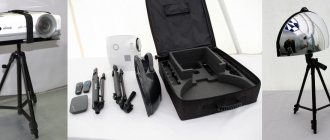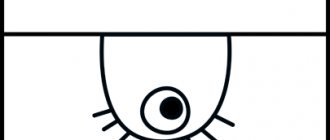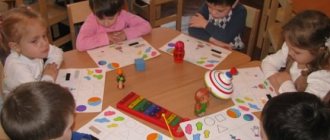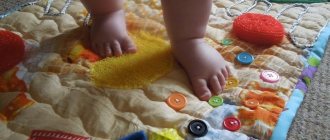The use of Lull circles in the work of a speech therapist teacher
The problem of speech in all its species diversity is relevant in preschool age. Today, there are many methods and technologies that can be used to correct the process of speech development in children. Lull's circles have firmly taken their place in pedagogy. Today they are a universal didactic tool that shapes the thinking processes of children. They can be used in many ways when solving problems of speech development in preschoolers with ODD. Lull circles introduce an element of play into the lesson and help maintain interest in the material being studied.
Working as a speech therapist with children of senior preschool age with ODD, I use them to solve the following problems:
- consolidation of the pronunciation of given sounds in speech;
- development of phonemic processes;
- clarification and activation of vocabulary;
- improving the syllabic structure of a word;
- formation of sentence structure;
- improving the development of coherent speech.
The work is carried out in all blocks of the educational process: in correctional classes, in individual work with children and in children’s independent play activities. Planning of a particular game is carried out depending on the correctional tasks being implemented at the moment, and the problems that arise over a certain period of time in specific children.
I present to your attention my system of game exercises for individual and subgroup speech therapy sessions using Lull circles.
Game tasks:
| |
| — On one circle there is a symbol of sound (for example, a snake), on the other there are object pictures with automated sound | Spin the wheel, pronounce words with the sound Ш. |
| — On one circle there are object pictures with automated sound (inanimate objects), on the other there are object pictures with automated sound (living objects) | “Name objects in pairs so that a living object is paired with a non-living object” “Come up with a sentence with the resulting pair of words.” For example: cat, closet (The cat hid under the closet. There is a cat drawn on the closet.) |
| — On the circles there are object pictures with a differentiable pair of sounds | “Come up with a sentence using the resulting pair of words.” For example: elephant - snowflake (The elephant caught the snowflake.) |
| |
| - On one circle there are blue, green, red circles, on the other - object pictures starting with vowels, hard - soft consonants | “Match the pictures with the symbols of the first sounds.” |
| — There are object pictures on the circles | “Match pictures with the same first sounds” |
| - On both circles there are subject pictures - paronyms | “Combine pictures that sound similar” For example: spoons - horns, bun - boxes, bear - bowl, etc. |
| — On one circle there are diagrams of the location of sounds in a word, on the other there are subject pictures | “Match the pictures with the matching diagrams” |
| |
| — On one circle there is a different number of dots, on the 2nd and 3rd there are object pictures | “Combine the number of dots with a word with the same number of syllables.” |
| — There are object pictures on both circles | “Match pictures with the same number of syllables.” For example: hat-ka - cha-sy, sa-mo-var - mo-lo-tok. “Come up with a sentence with the resulting pair of words.” For example: hat - watch I put my hat on my watch. |
| - On one circle there are syllables, on the other - syllables | “Read the resulting word” For example: MA, PA-MAPA, LO, TALOT “Add the word I named.” For example: KA, SHA - PORridge, RO, ZA - ROSE. “Come up with a sentence using the resulting word” |
| |
| — On one circle there are different numbers, on the 2nd color and on the 3rd there are object pictures | “Come up with a sentence with the resulting pair of words.” For example: 8 – pink – lamp (8 pink lamps.) |
| — On one circle there are diagrams of prepositions, on the 2nd and 3rd there are object pictures | “Come up with a sentence with the resulting pair of words.” For example: Pinocchio peeks out from behind a birch tree. |
As a result, I would like to note that as a result of working with this multifunctional manual, children at the end of the school year showed interest in using it in independent activities. I believe that Lull Rings are an effective tool in solving correctional problems. Their practical significance is obvious and deserves the attention of teachers of speech therapy groups and speech therapist teachers.
Literature:
- Lelyukh S., Sidorchuk T., Khomenko N. Development of creative thinking, imagination and speech of preschoolers. – Ulyanovsk, 2003.
- Sidorchuk T. I explore the world. Methodological complex for working with preschoolers. - Ulyanovsk, 2014.
Developmental manual for speech development “Rings of Lull”
1. Photo of a developmental manual.
2. Description of the algorithm for producing the manual.
To make a manual, you need to take: two rectangular pieces of any solid material, for example: plexiglass, plywood, thick cardboard, plastic, a width equal to the diameter of your rings, and a length 2-4 cm less than two diameters of the rings. On the bottom plate, in the places of the supposed centers of the rings, it is necessary to strengthen the pins. Build a small side around the perimeter, and attach legs or hinges to the bottom side. It is necessary to cut out a window in the upper rectangle so that the combined pictures are visible. If the game will only stand on the table, then the lid can not be attached, but simply placed on the sides of the base. If the manual can be hung on the wall, the cover must be secured.
For free and convenient rotation of the rings, it is proposed to use a base in the form of old gramophone records. It is convenient to rotate the circles by the protrusions, which are formed as a result of the fact that the width of the aid is 2-4 cm less than two diameters of the plates.
3. Problems that this manual helps solve.
- develop phonemic processes;
- clarify and activate vocabulary;
- improve the syllabic structure of words;
- automate speech sounds;
- form the structure of sentences;
- improve the development of coherent speech.
This game guide can be used to reinforce articulation exercises, correct the sound side of speech, and for the development of lexical and grammatical categories and coherent speech.
4. Option for using the manual.
Games that improve the sound aspect of speech and literacy: “Sound Circles.” “Zvukariki”, “Where is the sound hidden?”
Purpose of the games:
- improving sound analysis skills
- literacy training
- expansion and activation of the dictionary
Description: Games are played in pairs or with a subgroup of children. On the 1st circle there are pictures with the image of “sound” (pump-S, mosquito-Z, bee-Zh, snake-Sh..), on the 2nd circle there is a picture and a sound diagram. According to the rules of the game, you need to match the picture “sound” with a picture with a diagram and determine the position of the sound in the word. You can replace pictures with sound patterns with letters and call the sound that lives in its apartment a letter. The degree of difficulty of tasks should increase gradually. Children accompany all their actions with speech, consolidating the skills of sound analysis and acquired knowledge of literacy.
Games for the formation of lexical and grammatical categories: “Whose, whose, whose?”, “Form a word”, “One is many”, “Name it”, “Count it”
Purpose of the games:
- improving the lexical and grammatical structure of speech
- strengthening the skills of word formation and inflection.
- expansion and activation of the dictionary
- development of coherent speech
Description: The organization and conditions of the games are the same. On the 1st circle there is a picture of an animal or bird, on the 2nd circle there are parts of its body (tail, paws, ears, nose, wings...) or cubs, or a habitat, or several animals and birds. Children, spinning circles, select a pair, consolidating knowledge about the animal world and lexical and grammatical categories that they met in a lesson with a speech therapist. These game exercises reinforce the formation of a coherent independent statement.
Games that improve the development of articulatory motor skills: “Tongue exercises”, “Look and show”
Purpose of the games:
- improving children's articulation abilities
- development of visual gnosis and constructive praxis
- developing cooperation and independence skills
Description: The game is played in pairs or two subgroups of children. Take circles 1 with a picture of an articulation exercise, 2 with pictures corresponding to an articulation exercise (fungus, swing, fence, watch, cup). A picture is installed in one of the windows, the pair of which is selected by scrolling the second ring. In these games, one picture of circle 1 must correspond to a picture of circle 2. Children, by finding and selecting pictures, simultaneously consolidate their skills in performing articulation exercises, name articulation exercises and consolidate the poems learned for this exercise.
Authors: Daniliva Olga Ivanovna, teacher-speech therapist; Shumilina Evgenia Nikolaevna, teacher; MBDOU d/s general developmental type No. 53, Volzhsky, Volgograd region, Russia.
The article is published in the author's edition





